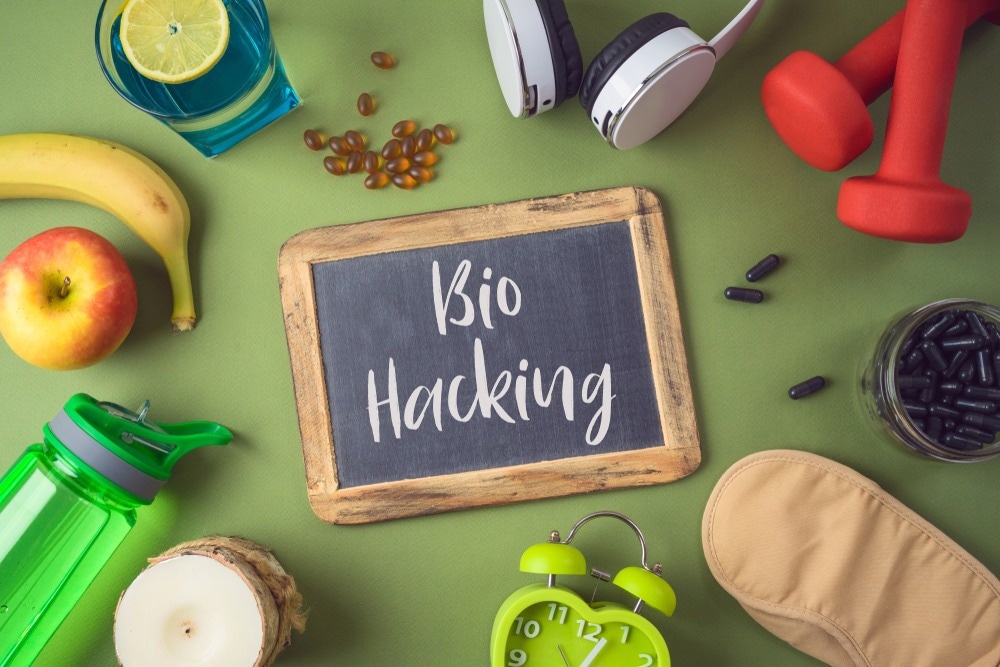Types of biohacking
Common biohacking practices
Ethical and safety concerns
References
Further reading
Biohacking is a do-it-yourself biology that helps people make changes in their bodies, diets, and lifestyle to enhance physical functionality and extend lifespan. With the advancement in biotechnology and genetics, biohacking has gained considerable attention in recent decades.

Image Credit: Maglara/Shutterstock.com
Biohacking is often practiced outside conventional research environments by scientists, ex-scientists, or non-scientists who form community laboratories or “hackspaces” to share ideas, knowledge, and equipment. The ever-increasing trend of biohacking raises potential ethical and safety concerns that need to be addressed by regulatory authorities.
The idea of hacking living systems (biohacking) emerged in the mid-2000s when genetic analysis tools such as sequencing have become highly cost-effective and widely available. Many scientists get involved in biohacking as a part of educational projects that aim to improve scientific knowledge about biotechnology and accelerate innovation.
Some prominent biohackers have recently argued that every individual has the right to modify their genes, which in turn can increase access to life-saving gene therapies.
Types of biohacking
Any strategy employed by an individual to enhance their biological activities can be considered biohacking. Lifestyle modification, such as dietary shifts, breathing practice, meditation, and exercise, is the most commonly practiced biohacking, which people employ to increase physical performance and longevity.
The use of natural and synthetic substances as supplements to enhance biological activities comes under molecular biohacking. The substances could be vitamins, minerals, or peptides. Administration of biologics through ingestion, injection, or intravenous transfusion to enhance biology is another type of biohacking. Biologics are cellular or biological components derived from natural and living sources. While some biologics require a physician’s prescription, some can be procured from non-medical stores without a prescription.
Technology-based biohacking includes wearable and diagnostic devices, such as smartwatches and blood pressure and glucose monitors. These devices generate a huge amount of physiological data, which helps biohackers manipulate their health and performance.
Many advanced devices, such as hyperbaric chambers or electromagnetic stimulators, are also used in technology-based biohacking to trigger faster physiological changes or healing. Some biohackers implant electronic devices, magnets, or radio-frequency identification (RFID) chips in their body to enhance physical performance and gain new sensory experiences.
The most complex type of biohacking is genetic engineering. Some infamous biohackers have done many experiments in this field. These experiments include full-body microbiome transplantation, telomerase gene therapy (anti-aging), and CRISPR DNA injection (muscle strength enhancement). Most of these experiments came under serious criticism and safety concerns by the scientific community.
Common biohacking practices
Dietary biohacking
Dietary and nutritional modifications are common biohacking practices that involve the consumption of dietary supplements (vitamins, minerals, antioxidants, essential fatty acids, and prebiotics and probiotics) to improve metabolism, boost energy production, improve insulin sensitivity, trigger weight loss, improve physical performance, prevent chronic diseases, and increase lifespan.
Dietary biohacking also includes specific dietary patterns, such as a ketogenic diet or intermittent fasting, to modulate energy production and metabolism. Understanding the relationship between the human genome, nutrition, and health (nutrigenomics) is a prerequisite for getting desired health outcomes from dietary biohacking. Another vital step included in dietary biohacking is the continuous use of cellular metabolism monitoring devices, such as blood glucose monitoring devices and ketone breath analyzers.
Energy biohacking
Energy biohacking is one of the most commonly used categories, which frequently includes sleep support and stress relief practices. These two practices are particularly crucial as sleep deprivation and chronic stress can negatively affect overall energy metabolism.
Light therapy is used to regulate the circadian rhythm and maintain the sleep cycle. Sleep tracking devices are used to monitor daily sleep patterns. Various meditation apps are also used for sleep support and stress relief. Other techniques that are used in energy biohacking include the consumption of vitamin B12 and magnesium supplements, wearing blue light protection glasses, and time-restricted caffeine intake.

Image Credit: YAKOBCHUK VIACHESLAV/Shutterstock.com
Physical health biohacking
Athletes often look for biohacking modalities to improve their physical performance and trigger recovery from injuries. Exercise itself is a valuable biohacking method that helps increase mitochondrial biogenesis, cellular energy metabolism, insulin sensitivity, and growth factor release, which collectively support cellular repair and regeneration.
Common physical health biohacking methods include cold therapy, heat therapy, whole body vibration therapy, pulsed electromagnetic field therapy, red light therapy for healing, and consumption of athletic supplements, such as creatine, amino acids, electrolytes, and energy drinks.
Age biohacking
Age biohacking mainly focuses on cellular senescence to improve longevity. Apoptosis, also known as programmed cell death, is a natural physiological process to remove damaged cells (senescent cells). With age, this process slows down, leading to the accumulation of senescent cells, induction of inflammation, disruption of adjacent cells, acceleration of the aging process, and onset of age-related diseases.
Inhibiting the production of senescent cells or reversing the process of cellular senescence is the primary area of focus in age biohacking to promote cellular health and regeneration. Commonly practiced methods include red light therapy, stem cell therapy, cryotherapy, non-ablative laser therapy, and consumption of anti-aging and mitochondrial support supplements (coenzyme Q10, polyphenols, L-carnitine, and Urolithin A).
Brain biohacking
Various neurotransmitter modulators, such as brain-derived neurotrophic factor (BDNF), play vital roles in promoting neurogenesis (formation of new neurons) and neuroplasticity (formation of new connections between neurons). High levels of these modulators in the brain are associated with improved cognitive and memory functions and neuroprotection.
In addition to increasing BDNF levels through exercise, brain biohackers often rely on consuming nootropics to enhance their cognitive efficiency. Other common practices include brainwave entrainment, transcranial magnetic stimulation therapy, neurofeedback therapy, brainwork, brain games, and meditation.
Ethical and safety concerns
Although biohacking is a powerful concept to support physical and mental health promotion, some forms of it, including genetic manipulations and self-administration of unregulated drugs, can present serious public health risks.
The authorized scientific community should actively engage with the biohacking community to ensure the safe and secure application of scientific approaches and to prevent unethical and illegal use of biological materials.
References
Further Reading
Last Updated: Nov 27, 2023